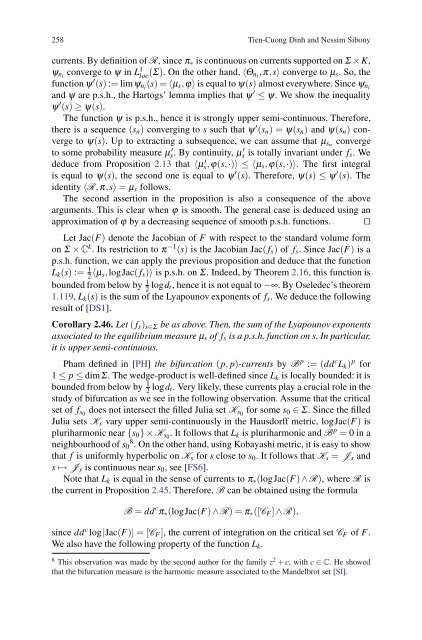Discrete Holomorphic Local Dynamical Systems
Discrete Holomorphic Local Dynamical Systems
Discrete Holomorphic Local Dynamical Systems
You also want an ePaper? Increase the reach of your titles
YUMPU automatically turns print PDFs into web optimized ePapers that Google loves.
258 Tien-Cuong Dinh and Nessim Sibony<br />
currents. By definition of R,sinceπ∗ is continuous on currents supported on Σ ×K,<br />
ψni converge to ψ in L1 loc (Σ). On the other hand, 〈Θni ,π,s〉 converge to μs. So,the<br />
function ψ ′ (s) := limψni (s)=〈μs,ϕ〉 is equal to ψ(s) almost everywhere. Since ψni<br />
and ψ are p.s.h., the Hartogs’ lemma implies that ψ ′ ≤ ψ. We show the inequality<br />
ψ ′ (s) ≥ ψ(s).<br />
The function ψ is p.s.h., hence it is strongly upper semi-continuous. Therefore,<br />
there is a sequence (sn) converging to s such that ψ ′ (sn) =ψ(sn) and ψ(sn) converge<br />
to ψ(s). Up to extracting a subsequence, we can assume that μsn converge<br />
to some probability measure μ ′ s. By continuity, μ ′ s is totally invariant under fs. We<br />
deduce from Proposition 2.13 that 〈μ ′ s ,ϕ(s,·)〉 ≤〈μs,ϕ(s,·)〉. The first integral<br />
is equal to ψ(s), the second one is equal to ψ ′ (s). Therefore, ψ(s) ≤ ψ ′ (s). The<br />
identity 〈R,π,s〉 = μs follows.<br />
The second assertion in the proposition is also a consequence of the above<br />
arguments. This is clear when ϕ is smooth. The general case is deduced using an<br />
approximation of ϕ by a decreasing sequence of smooth p.s.h. functions. ⊓⊔<br />
Let Jac(F) denote the Jacobian of F with respect to the standard volume form<br />
on Σ × C k . Its restriction to π −1 (s) is the Jacobian Jac( fs) of fs. SinceJac(F) is a<br />
p.s.h. function, we can apply the previous proposition and deduce that the function<br />
Lk(s) := 1 2 〈μs,logJac( fs)〉 is p.s.h. on Σ. Indeed, by Theorem 2.16, this function is<br />
bounded from below by 1 2 logdt, hence it is not equal to −∞. By Oseledec’s theorem<br />
1.119, Lk(s) is the sum of the Lyapounov exponents of fs. We deduce the following<br />
result of [DS1].<br />
Corollary 2.46. Let ( fs)s∈Σ be as above. Then, the sum of the Lyapounov exponents<br />
associated to the equilibrium measure μs of fs is a p.s.h. function on s. In particular,<br />
it is upper semi-continuous.<br />
Pham defined in [PH] the bifurcation (p, p)-currents by Bp :=(ddcLk) p for<br />
1 ≤ p ≤ dimΣ. The wedge-product is well-defined since Lk is locally bounded: it is<br />
bounded from below by 1<br />
2 logdt. Very likely, these currents play a crucial role in the<br />
study of bifurcation as we see in the following observation. Assume that the critical<br />
set of fs0 does not intersect the filled Julia set Ks0 for some s0 ∈ Σ. Since the filled<br />
Julia sets Ks vary upper semi-continuously in the Hausdorff metric, logJac(F) is<br />
pluriharmonic near {s0}×Ks0 . It follows that Lk is pluriharmonic and Bp = 0ina<br />
neighbourhood of s0 8 . On the other hand, using Kobayashi metric, it is easy to show<br />
that f is uniformly hyperbolic on Ks for s close to s0. It follows that Ks = Js and<br />
s ↦→ Js is continuous near s0, see[FS6].<br />
Note that Lk is equal in the sense of currents to π∗(logJac(F) ∧ R), whereRis the current in Proposition 2.45. Therefore, B can be obtained using the formula<br />
B = dd c π∗(logJac(F) ∧ R)=π∗([CF] ∧ R),<br />
since dd c log|Jac(F)| =[CF ], the current of integration on the critical set CF of F.<br />
We also have the following property of the function Lk.<br />
8 This observation was made by the second author for the family z 2 + c, with c ∈ C. Heshowed<br />
that the bifurcation measure is the harmonic measure associated to the Mandelbrot set [SI].



